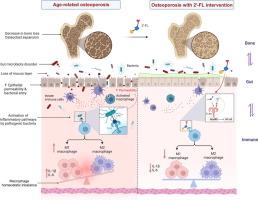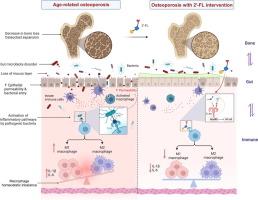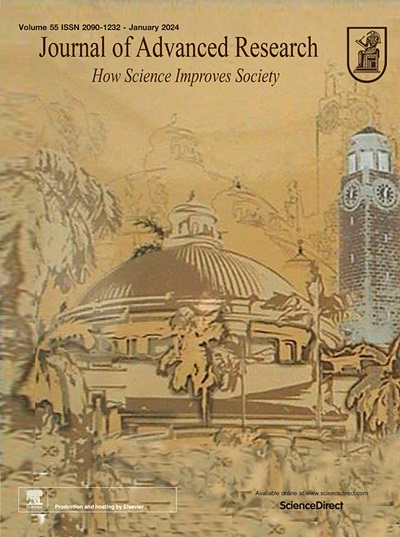2′-岩藻糖半乳糖通过恢复肠道微生物和先天性免疫平衡改善与衰老相关的骨质疏松症
IF 13
1区 综合性期刊
Q1 MULTIDISCIPLINARY SCIENCES
引用次数: 0
摘要
引言 与衰老相关的骨质疏松症被认为是中老年人严重的公共健康问题,其发病机制错综复杂,包括最近发现的衰老诱发的免疫功能障碍和肠道微生物紊乱。作为一种明确的益生元,2′-岩藻酸半乳糖(2′-FL)已被证实对全身健康具有积极作用,本研究拟揭示其对与衰老相关的骨质疏松症的干预作用,以及涉及肠道微生态和先天性免疫的潜在机制。方法通过评估自然衰老小鼠骨质流失和微结构损伤的严重程度,确定膳食 2′-FL 对骨质疏松症表型的影响。分析了依赖于先天性免疫概况、肠道屏障功能和肠道微生物平衡的机制,以阐明信号轴。结果表明,对自然衰老小鼠进行为期 12 周的 2′-FL 干预后,其骨质流失和微观结构损伤得以恢复。此外,2′-FL 还能缓解衰老引起的结肠炎症、肠道屏障功能障碍和肠道紧密连接蛋白的异常表达。2′-FL 治疗对衰老诱导的肠道微生物菌群失调的影响通过恢复肠道微生物群的多样性、恢复双歧杆菌、普雷沃特氏菌和阿克曼氏菌的丰度以及抑制僵直单胞菌的生长得到了验证。流式细胞术分析表明,树突状细胞(DC)和巨噬细胞亚群随着年龄的增长而发生变化。结论:这些发现强调了 2′-FL 通过调节肠道微生物稳态和先天性免疫反应对衰老相关性骨质疏松症的预防作用。本文章由计算机程序翻译,如有差异,请以英文原文为准。


2′-Fucosyllactose ameliorates aging-related osteoporosis by restoring gut microbial and innate immune homeostasis
Introduction
Aging-related osteoporosis is considered as a serious public health concern for middle-aged and elderly people, with an intricated pathogenesis including the recently identified aging-induced immunological dysfunction and gut microbial disorder. The intervention based on dietary prebiotics is recommended to retain bone health and postpone the progression of osteoporosis.
Objectives
As a well-defined prebiotic, 2′-fucosyllactose (2′-FL) has been thoroughly validated with positive effect on systemic health and was proposed in this study to unveil its intervention on aging-related osteoporosis, as well as the underlying mechanisms involving the gut microecology and innate immunity.
Methods
The effects of dietary 2′-FL on osteoporosis phenotypes were identified by evaluating the severity of bone loss and microstructure damage in natural aging mice. The mechanisms relying on innate immune profile, intestinal barrier function, and gut microbial homeostasis, were analyzed to elucidate the signaling axis. The detailed molecular signaling was validated based on LPS-stimulated RAW 264.7 murine macrophages.
Results
The results indicated that 12-week 2′-FL intervention retrieved bone loss and microstructure damage in natural aging mice. Also, 2′-FL alleviated aging-induced colonic inflammation, gut barrier dysfunction, and abnormal expression of intestinal tight-junction protein. The impact of 2′-FL treatment on the aging-induced gut microbial dysbiosis was validated by restoring gut microbiota diversity, recovering the abundance of Bifidobacterium, Prevotellaceae and Akkermansia, and inhibiting the growth of Stenotrophomonas. Flow cytometry analysis revealed changes in dendritic cell (DC) and macrophage subsets with age, and a decrease in M1-polarized macrophages was observed in 2′-FL-treated aged mice and RAW264.7 cells potentially through the interaction with toll-like receptor 4 (TLR4) to suppress NF-κB signaling and the secretion of proinflammatory factors.
Conclusion
These findings highlight the preventive effect of 2′-FL on aging-associated osteoporosis by regulating gut microbial homeostasis and innate immune responses.
求助全文
通过发布文献求助,成功后即可免费获取论文全文。
去求助
来源期刊

Journal of Advanced Research
Multidisciplinary-Multidisciplinary
CiteScore
21.60
自引率
0.90%
发文量
280
审稿时长
12 weeks
期刊介绍:
Journal of Advanced Research (J. Adv. Res.) is an applied/natural sciences, peer-reviewed journal that focuses on interdisciplinary research. The journal aims to contribute to applied research and knowledge worldwide through the publication of original and high-quality research articles in the fields of Medicine, Pharmaceutical Sciences, Dentistry, Physical Therapy, Veterinary Medicine, and Basic and Biological Sciences.
The following abstracting and indexing services cover the Journal of Advanced Research: PubMed/Medline, Essential Science Indicators, Web of Science, Scopus, PubMed Central, PubMed, Science Citation Index Expanded, Directory of Open Access Journals (DOAJ), and INSPEC.
 求助内容:
求助内容: 应助结果提醒方式:
应助结果提醒方式:


